I Took an Alaskan Cruise to See Bears, Killer Whales, and Secret Beaches — Here's How You Can, Too
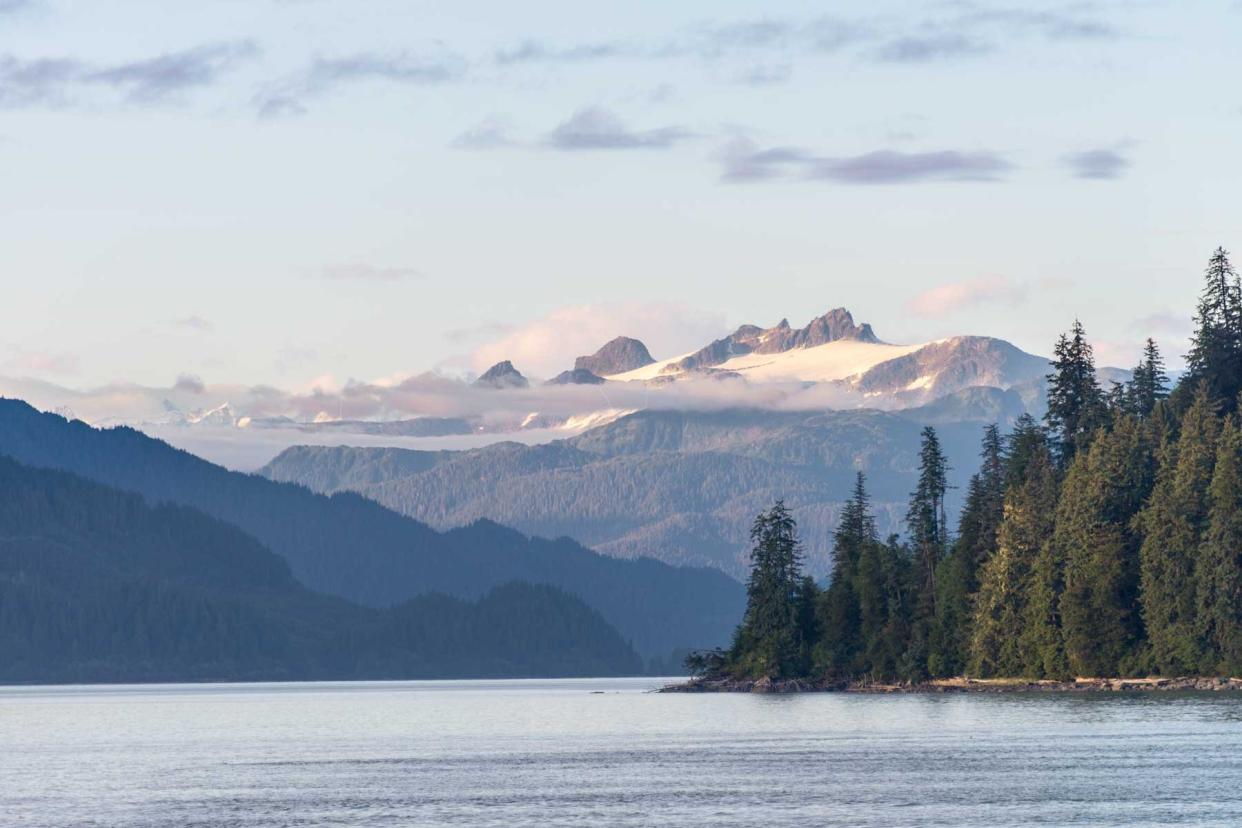
David Swanson Part of the Boundary Ranges, which flank the Alaska-Canada border.
Just after dawn in Farragut Bay, a placid inlet that opens onto Alaska's Inside Passage, I watched as mist slowly crept through the forest that gripped the shoreline. Low-lying clouds blanketed the horizon, but I could see the promise of a sunny morning as I climbed into a sturdy Zodiac belonging to the 128-foot expedition ship Kruzof Explorer.
I was setting off for a beach walk onshore with 10 other passengers, plus expedition leader Simon Hook. Just as the engine revved up, Hook pulled back the throttle. "Killer whales — over there," he said, pointing at a pair of ink-black fins slipping into the water about 100 feet off our starboard.
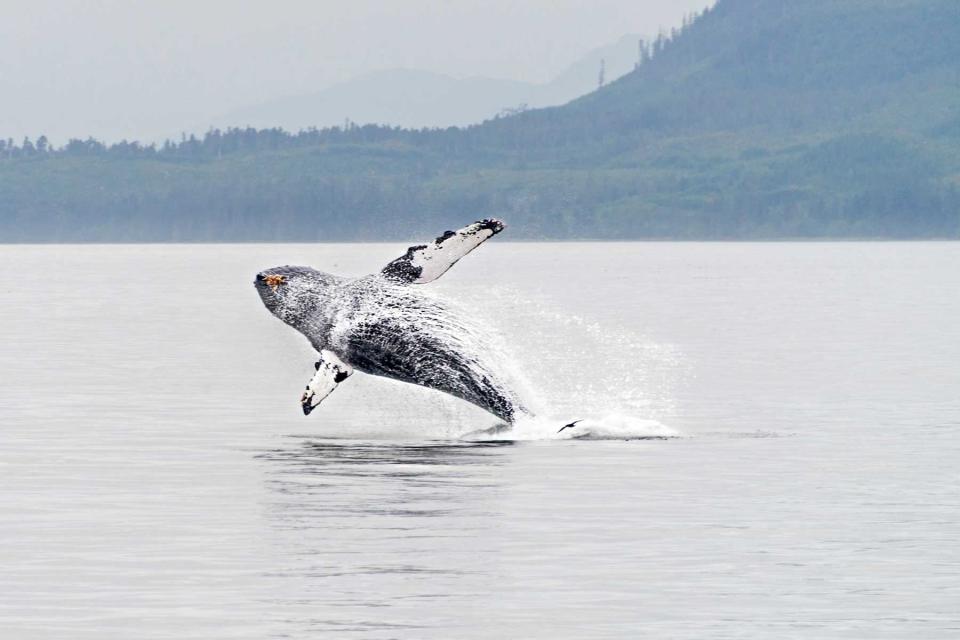
David Swanson A humpback whale breaches in Frederick Sound.
My heart pulsed as Hook wheeled the craft around and slowly motored parallel to the whales' path. They resurfaced four more times — we snapped as many pictures as we could — before disappearing into the bay. Only about 300 of the creatures inhabit the waters between Ketchikan and Yakutat, Hook explained, so seeing two in one morning was incredibly fortunate.
We would have plenty more opportunities to spot wildlife on our weeklong Alaskan Bear Country & Wilderness trip — one of many itineraries accommodating this season's high demand for trips to the 49th state. Owned by a Tlingit family, Alaskan Dream Cruises operates a fleet of six rustic boats out of Sitka, a port in the state's southeast. One big draw of sailing with the company is the enthusiastic staff, who either live in the state year round or have multiple summers of experience there and are, therefore, able to impart next-level knowledge of the terrain and wildlife.
The Bear Country itinerary, which launched last year, sails along the Alexander Archipelago from Sitka to Juneau and immerses travelers in the state's uninhabited forests and hidden beaches. The Kruzof Explorer's six passenger cabins — small, but suitable, and most with queen beds — sit just above the waterline. On the top deck is a light-filled dining room and bar where we passengers spent much of our downtime. At the rear are kayaks, paddleboards, the Zodiac, and a fishing skiff. The five-ton crane, which was used for hauling crab pots before the fishing boat was converted to a passenger vessel, now transfers the Zodiac and the skiff into and out of the water.
We had kicked off our first day on board with an excursion to Hidden Falls Hatchery, on Baranof Island. As a steady rain began to fall, we shook off the dreary weather and focused on the excitement of seeing a salmon run. A smart wilderness guide, Hook knew not to tip his hand too much by promising sightings that may not materialize. So when we arrived at a small dam, where the salmon were valiantly attempting to jump into one of the hatchery's man-made chutes, we were pleasantly surprised to see our first bears — coastal browns, Hook told us.
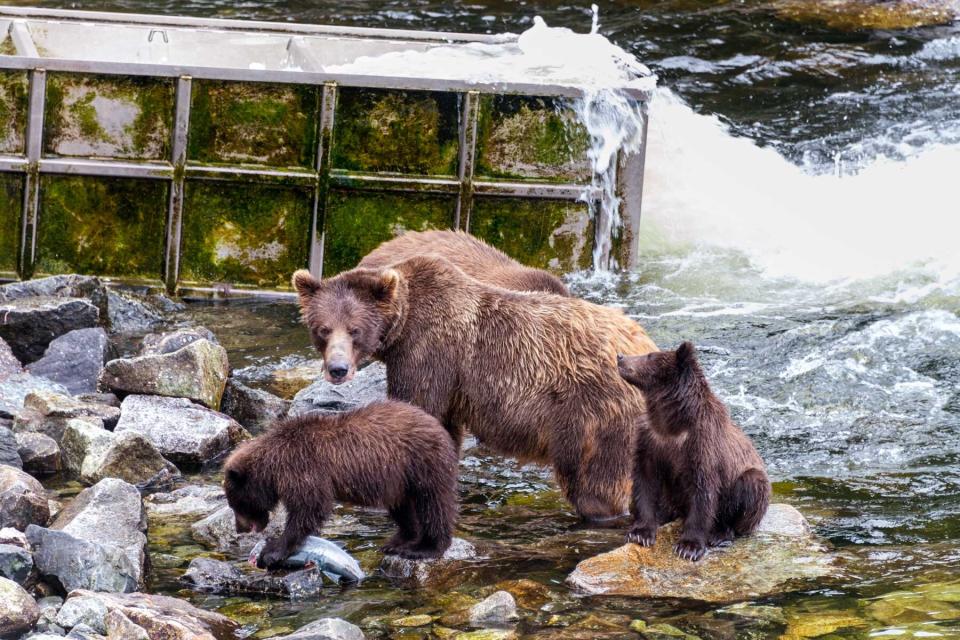
David Swanson Coastal brown bears fish for salmon near Hidden Falls on Baranof Island, in Alaska.
I counted 11 bears. Mothers and cubs were lazily feasting on the bounty of salmon. Juvenile males would plod into the cove to grab fish, then nervously scoot away, as if they didn't want to be caught stealing. They would hold the fish in their paws, pull off the skin first, then munch on the flesh before splitting open the belly to inhale the roe.
It was late in the season, so the bears were plump. It seemed like a kind of lethargy had set into their routine. But the spectacle was still irresistible, even as the rain pelted harder.
The next morning, we woke to a powder-blue sky stretching over Kuiu Island. We were the only people on the water, so we kayaked amid the kind of stillness my daily life in San Diego sorely lacks. Following our onboard lunch, which showcased halibut and other local seafood, we headed for a walk on a rocky beach, where among the smooth black stones I spotted a knuckle-size nugget with fanlike ridges. "It's a brachiopod fossil," Hook said. "About 300 million years old."
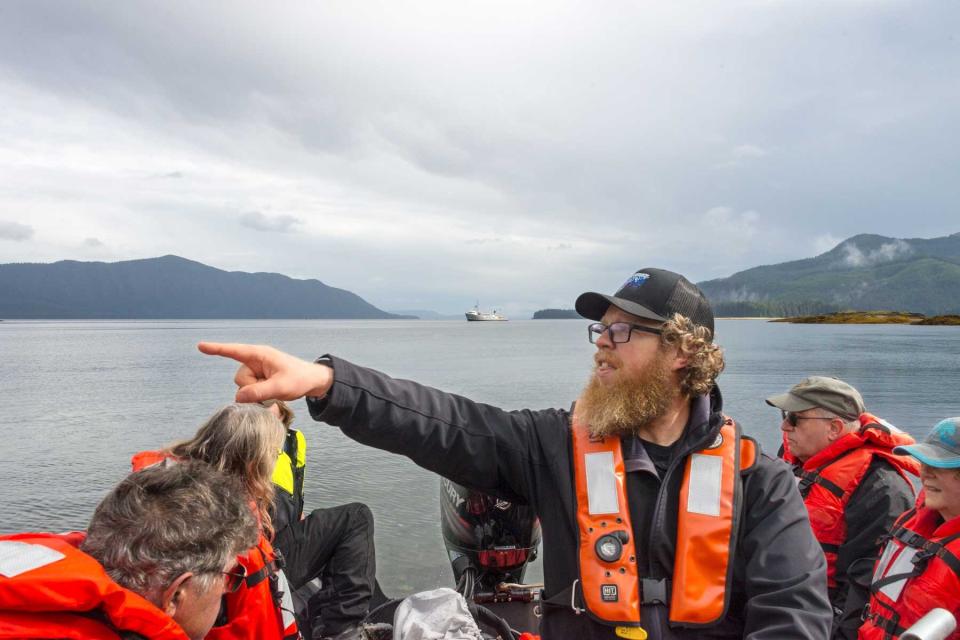
David Swanson Expedition leader Simon Hook pilots a Zodiac toward shore.
In the afternoon, as we headed into Frederick Sound, we spotted a pair of humpbacks feeding. Despite having made multiple trips through Alaska's southeast, this was my first time witnessing what's known as bubble-net behavior. As Hook explained, the whales swim under the krill or herring in an upward spiral, while exhaling a "net" of bubbles that corrals the fish into a tight ball. We watched with rapt attention as the whales lunged toward the surface, mouths agape, to scoop up the dizzied prey. Hovering over the surface were hundreds of birds: sooty shearwaters and Cassin's auklets that were anticipating where the fish would pop up.
As we headed south in the dusk, more humpbacks emerged and a giddy performance began as the whales breached, one at a time. Each had its own trajectory — some headed almost straight up and then crashed down on their sides; others landed on their backs.
After that spectacle, we continued south toward the island town of Wrangell, where we were set to anchor for the night. Watching the sunset from the decks — with cocktails prepared by Jessica Machay, the ship's congenial steward and bartender — was glorious.
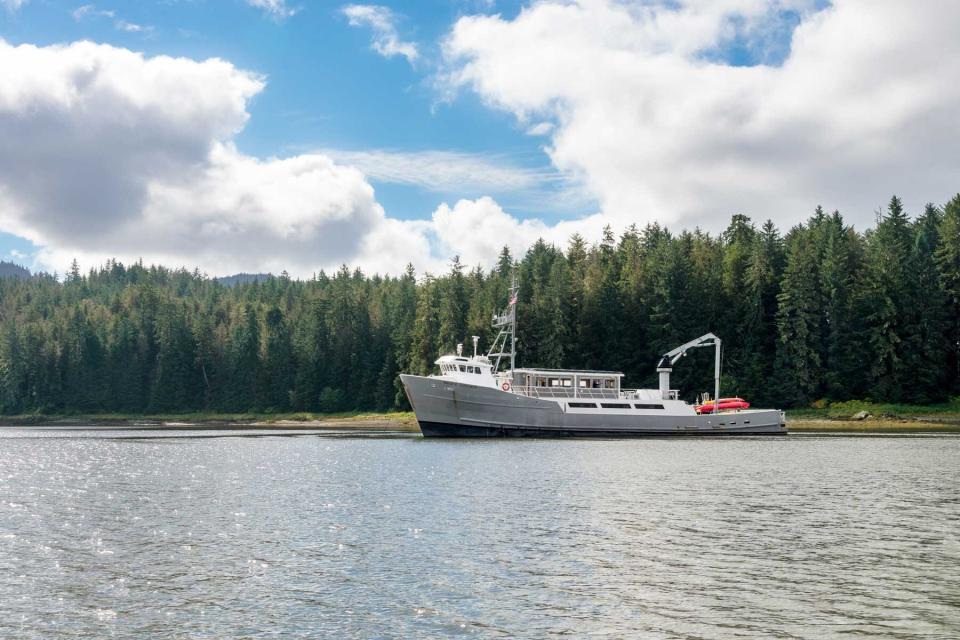
David Swanson The Kruzof Explorer anchors near Farragut Bay.
In the morning, we hopped onto a sleek jet boat to access the Anan Wildlife Observatory on the mainland, 30 miles away. We arrived at the renowned bear-watching site shortly after the start of the official season, July 5 to August 25, during which just 72 viewing permits are issued each day. Escorted by two rangers carrying rifles, we followed a trail through a forest of Sitka spruce and western hemlock to a deck that overlooked a set of gushing falls.
Several of us descended into a cramped photo hide. A few minutes later, I heard the click of Hook's camera. The snout of a diminutive black bear had appeared from behind a rock, right at the water's edge. Then other, bigger bears materialized, walking on top of the downed trees that lined the riverbank.
The poor salmon repeatedly attempted to crest the falls, but most failed and pooled up at the bear's feet. The animals seemed oblivious to us. Inside the hide, I had an anxious moment when one of the carnivores strutted less than 10 feet away from us. Eventually bears appeared on all sides of the deck above the hide, which was nominally protected by a railing (and our armed guides). As we were walking back to the jet boat, a grizzly mama watched as her three cubs played on the opposite side of the estuary.
Our trip into Tracy Arm was no less thrilling. I had previously traveled through this sheer-walled fjord and viewed its sapphire-blue terminus from high up on the deck of a large cruise ship. But encountering the tidewater glacier aboard this smaller craft brought home the immensity of the ice sheet.
As the Kruzof's crane maneuvered to lift the Zodiac into the channel, which was chunky with shards of ice, I asked Hook what to wear. He replied, "Everything you brought." Before clambering into the Zodiac, I doubled up on T-shirts and socks, wishing I'd paid closer attention to the packing list (gloves!).
Nearby, a mountain goat and her offspring scaled one craggy wall of the scree-littered terrain. In the distance, I could see dozens of black spots on bergs that had calved from the glacier. As we shuttled closer, it became clear that the blobs were harbor seals, seemingly unfazed by the cacophony created as sheets of ice tumbled into the water.
Between crashes, after Hook shut off the Zodiac's motor, I was prepared to hear the blissful silence of 13 people, sitting in awe. I listened for it, but instead, I cued into a sizzling sound coming from the water around us — the crackle of trapped air bubbles being released as the floating icebergs melted. I had come to Alaska for the wildlife. Who knew the mists and the ice would be alive as well?
Alaskan Dream Cruises offers seven-day Alaskan Bear Country & Wilderness itineraries that start at $8,525.
A version of this story originally appeared in the July 2022 issue of Travel + Leisure under the headline Pure and Simple.


